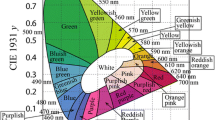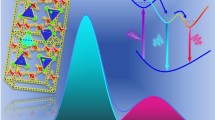Abstract
In this study, L-threonine containing trivalent europium ions (LTHEu) was successfully grown through the slow evaporation method. The LTHEu single crystal exhibit well-defined facets, with dimensions around 5 × 13 × 4 mm. Structural, thermal, and spectroscopic properties were characterized by X-ray diffraction (XRD), Fourier transform infrared spectroscopy, X-ray fluorescence (XRF), thermogravimetric analysis, differential thermal analysis, ultraviolet–visible absorption spectroscopy, and photoluminescence spectroscopy. Rietveld refinement of XRD data showed that the LTHEu crystal crystallizes in an orthorhombic system with P212121-space group. The Eu3+ ions promote an expansion effect on the unit cell volume. XRF measurements confirm the presence of the Eu3+-impurities in the L-threonine matrix. In addition, the LTHEu crystal showed thermal stability for temperatures up to 483 K. Spectroscopic analysis revealed light emission with orange color due to the combination of high-intensity bands related to 5D0→7F1 (orange) and 5D0→7F2 (red) electronic transitions of Eu3+ ions. The new emission for L-threonine crystal doped with Eu3+ observed in this study expands the range of materials with potential for application in optical devices in the visible region.






Similar content being viewed by others
Data availability
Data can be available from the corresponding author (joaogomes.quimico@gmail.com) upon academic reasonable request.
References
K. Zhu, Z. Chen, Y. Wang, H. Liu, Y. Niu, X. Yi, Y. Wang, X. Yuan, G. Liu, (M, Ca)AlSiN3: Eu2+ (M = Sr, Mg) long persistent phosphors prepared by combustion synthesis and applications in displays and optical information storage. J. Lumin. 252, 119288 (2022). https://doi.org/10.1016/j.jlumin.2022.119288
H. Hu, W. Zhang, Synthesis and properties of transition metals and rare-earth metals doped ZnS nanoparticles. Opt. Mater. (Amst). 28, 536–550 (2006). https://doi.org/10.1016/j.optmat.2005.03.015
S. Rajyalakshmi, K. Ramachandra Rao, B. Brahmaji et al., Investigations on structural and photoluminescence mechanism of cerium doped L -Histidine hydrochloride mono hydrate single crystals for optical applications. J. Mol. Struct. 1129, 231–238 (2017). https://doi.org/10.1016/j.molstruc.2016.09.069
S. Rajyalakshmi, K. Ramachandra Rao, B. Brahmaji et al., Optical investigations on Tb3+ doped L-Histidine hydrochloride mono hydrate single crystals grown by low temperature solution techniques. Opt. Mater. (Amst). 54, 74–83 (2016). https://doi.org/10.1016/j.optmat.2016.02.014
K. Ramachandra Rao, S. Rajyalakshmi, C.S. Kamal et al., Unique optical properties of Eu3+ doped L-histidine hydrochloride mono hydrate single crystals from low temperature growth technique. Spectrochim Acta - Part A Mol Biomol Spectrosc. 176, 52–57 (2017). https://doi.org/10.1016/j.saa.2016.12.039
B. Brahmaji, S. Rajyalakshmi, C. Satya et al., Optical emissions of Ce3+ doped sulphamic acid single crystals by low temperature unidirectional growth technique. Opt. Mater. (Amst). 64, 100–105 (2017). https://doi.org/10.1016/j.optmat.2016.11.040
A. Karolin, K. Jayakumari, C.K. Mahadevan, Growth and characterization of pure and Ni2+ doped glycine sodium sulfate crystals. Int. J. Res. Eng. Technol. 02, 646–651 (2013). https://doi.org/10.15623/ijret.2013.0212110
M.H. Fang, Z. Bao, W.T. Huang, R.S. Liu, Evolutionary generation of phosphor materials and their progress in future applications for light-emitting diodes. Chem. Rev. 122(13), 11474–11513 (2022). https://doi.org/10.1021/acs.chemrev.1c00952
M. Kim et al., Discovery of a Quaternary Sulfide, Ba2–xLiAlS4: Eu2+, and its potential as a fast-decaying LED phosphor. Chem. Mater. 32, 6697–6705 (2020). https://doi.org/10.1021/acs.chemmater.0c02243
J.W. Lee et al., Metaheuristics-Assisted Combinatorial Screening of Eu2+-Doped Ca–Sr–Ba–Li–Mg–Al–Si–Ge–N Compositional Space in Search of a Narrow-Band Green Emitting Phosphor and Density Functional Theory Calculations. Inorg. Chem. 56, 9814–9824 (2017). https://doi.org/10.1021/acs.inorgchem.7b01341
Y. Zhang et al., Pore-existing Lu3Al5O12: Ce ceramic phosphor: an efficient green color converter for laser light source. J. Lumin. 197, 331–334 (2018). https://doi.org/10.1016/j.jlumin.2018.01.014
Z. Wang et al., Electronic structure descriptor for the discovery of narrow-band red-emitting phosphors. Chem. Mater. 28, 4024–4031 (2016). https://doi.org/10.1021/acs.chemmater.6b01496
G. Heliotis et al., Spectral conversion of InGaN ultraviolet microarray light-emitting diodes using fluorene-based red-, green-, blue-, and white-light-emitting polymer overlayer films. Appl. Phys. Lett. 87, 103505 (2005). https://doi.org/10.1063/1.2039991
J. Wang et al., Fluorescent/luminescent detection of natural amino acids by organometallic systems. Coord. Chem. Rev. 303, 139–184 (2015). https://doi.org/10.1016/j.ccr.2015.05.008
O. Yuji, in Structural determination of unstable species, ed. by C.A. Jan, Models mysteries and magic of molecules, (Springer, Berlin Heidelberg, 2008) pp. 109–135
R.E. Marsh, J. Donohue, Crystal structure studies of amino acids and peptides. Adv. Prot. Chem. 22, 235–2561 (1967). https://doi.org/10.1016/S0065-3233(08)60042-X
M. Fleck, Salts of Amino Acids. Crystallization, Structure and Properties (Springer International Publishing, Cham, Switzerland, 2014), pp. 21–82
B. Bathe, (2003) Microbial production of l-amino acids Springer Science & Business Media, Amsterdam pp. 113–136
S. Zhang et al., A novel cytotoxic ternary copper(II) complex of 1,10-phenanthroline and l-threonine with DNA nuclease activity. J. Inorg. Biochem. 98, 2099–2106 (2004). https://doi.org/10.1016/j.jinorgbio.2004.09.014
R. Subhashini et al., Growth and characterization of Bis(L-threonine) copper (II) monohydrate single crystals: a semiorganic second order nonlinear optical material. Opt. Mater. (Amst). 62, 357–365 (2016). https://doi.org/10.1016/j.optmat.2016.09.041
J. Zhu et al., Europium (III) doped LiNa2B5P2O14 phosphor: surface analysis, DFT calculations and luminescent properties. J. Alloys Compd. 822, 153606 (2020). https://doi.org/10.1016/j.jallcom.2019.153606
J. Qiao et al., Divalent europium-doped near-infrared-emitting phosphor for light-emitting diodes. Nat. Commun. 10, 1–7 (2019). https://doi.org/10.1038/s41467-019-13293-0
A. Azhagiri, V. Ponnusamy, R. Satheesh Kumar, A development of new red phosphor based on europium doped as well as substituted Barium Lanthanum Aluminate (BaLaAlO4: Eu3+). Opt. Mater. (Amst) 90, 127–138 (2019). https://doi.org/10.1016/j.optmat.2019.02.024
H. Zhou et al., Novel ratiometric optical thermometry based on dual luminescent centers from europium doped LiCa3MgV3O12 phosphor. Ceram. Int. 45, 16651–16657 (2019). https://doi.org/10.1016/j.ceramint.2019.05.207
Z. Rzaczynska et al., The properties and crystal structure of catena-poly[praseodymium(III) -hexaaqua-µ-L-threonine-κ3O, O’, O’’]tricchloride and catena-poly(pentaaqua-µ-L-threonine-κ3O, O’, O’’) europium(III) and ytterbium(III) trichlorides. Pol J Chem 73, 1259–1272 (1999)
R.C. Santana et al., Growth, EPR and optical absorption spectra of L-threonine single crystals doped with Cu2+ ions. J. Phys. Chem. Solids. 68, 586–593 (2007). https://doi.org/10.1016/j.jpcs.2007.01.0
K. Kanagasabapathy, R. Rajasekaran, Growth, structural, optical and thermal studies of L-Threonine added zinc(tris) Thiourea Sulphate single crystals. J. Optoelectron. Adv. Mater. 6, 218–224 (2012)
J. Oliveira Neto, G, et al., Structural, vibrational, thermal, and optical properties of L-threonine crystals containing Ce3+ ions. J. Mol. Struct. 1254, 132316 (2022). https://doi.org/10.1016/j.molstruc.2021.132316
M. Zhu, Q. Ma, N. Guo, Optical thermometry based on europium doped self-activated dual-emitting LiCa3ZnV3O12 phosphor. Spectrochim Acta - Part A Mol Biomol Spectrosc. 271, 120922 (2022). https://doi.org/10.1016/j.saa.2022.120922
S.K. Pathak, A. Verma, A. Verma, Structural and photoluminescence properties of Eu3+ activated ZnAl2O4 orange-red phosphor. J. Mater. Sci. Mater. Electron. 31, 16137–16149 (2020). https://doi.org/10.1007/s10854-020-03715-x
S. Khatri et al., Photophysical, optical and lasing analysis of fluorinated β-keto carboxylate europium(III) complexes. Mater. Res. Express. 1, 1–33 (2019). https://doi.org/10.1088/2050-6120/ac98f5
B.H. Toby, EXPGUI, a graphical user interface for GSAS. J. Appl. Crystallogr. 34, 210–213 (2001). https://doi.org/10.1107/S0021889801002242
G.R. Kumar et al., Growth, structural, optical and thermal studies of non-linear optical L-threonine single crystals. J. Cryst. Growth. 267, 213–217 (2004). https://doi.org/10.1016/j.jcrysgro.2004.03.073
P.R. Selvin, Principles and biophysical applications of lanthanide-based probes. Biophys. Biomol. Struct. 31, 275–302 (2002). https://doi.org/10.1146/annurev.biophys.31.101101.140927
A.L. Patterson, The scherrer formula for X-ray particle size determination. Phys. Rev. 56, 978–982 (1939). https://doi.org/10.1103/PhysRev.56.978
G.K. Williamson, W.H. Hall, X-ray line broadening from filed aluminium and wolfram. Acta Metall. 1, 22–31 (1953). https://doi.org/10.1016/0001-6160(53)90006-6
V.M. Malhotra, S. Jasty, R. Mu, FT-IR spectra of Water in microporous pellets and water’s desorption kinetics. Appl. Spectrosc. 43(4), 638–645 (1989). https://doi.org/10.1366/0003702894202643
K.A. Guzzetti et al., Structural and vibrational study on zwitterions of L -threonine in aqueous phase using the FT-Raman and SCRF calculations. J. Mol. Struct. 1045, 171–179 (2013). https://doi.org/10.1016/j.molstruc.2013.04.016
Y.C. Lien, W.W. Nawar, Thermal decomposition of some amino acids. valine, leucine and lsoleucine. J. Food Sci. 39(5), 911–913 (1974). https://doi.org/10.1111/j.1365-2621.1974.tb07274.x
G.Q. Zhong, Q. Zhong, Solid–solid synthesis, characterization, thermal decomposition and antibacterial activities of zinc(II) and nickel(II) complexes of glycine–vanillin Schiff base ligand. Green. Chem. Lett. Rev. 3, 236–242 (2014). https://doi.org/10.1080/17518253.2014.927008
N. Kiran, Eu3+ ion doped sodium-lead borophosphate glasses for red light emission. J. Mol. Struct. 1065–1066, 93–98 (2014). https://doi.org/10.1016/j.molstruc.2014.02.047
K. Swapna et al., Luminescence characterization of Eu3+ doped zinc Alumino Bismuth Borate glasses for visible red emission applications. J. Lumin. 156, 80–86 (2014). https://doi.org/10.1016/j.jlumin.2014.07.022
J.K. Park et al., Photoluminescence properties of the Eu3+ in La2O3. J. Mater. Sci. Lett. 20, 2231–2232 (2001). https://doi.org/10.1023/A:1017997320503
T. Samuel et al., Photoluminescence enhancement and energy transfer mechanism of Bismuth added LaGaO3:Eu nanophosphor for display applications. Optik (Stuttg). 127, 10575–10587 (2016). https://doi.org/10.1016/j.ijleo.2016.08.063
S.J. Dhoble et al., Synthesis of Sr5SiO4Cl6: Eu3+, NaAlSiO4: Tb3+ and Sr2P2O7: Dy3+ phosphors for solid state lighting applications. Optik (Stuttg) 126, 1527–1533 (2015). https://doi.org/10.1016/j.ijleo.2015.04.042
S. Zhang J, Study on UV excitation properties of Eu3+-doped rare-earth phosphates. J. Lumin. 122–123, 500–502 (2007). https://doi.org/10.1016/j.jlumin.2006.01.218
A. Mezzi et al., Structure and composition of electrospun titania nanofibres doped with Eu. Surf. Interface Anal. 42, 572–575 (2010). https://doi.org/10.1002/sia.3275
A.K. Parchur et al., Luminescence properties of Eu3+ doped CaMoO4 nanoparticle. Dalton Trans. 40(29), 7595–7601 (2011). https://doi.org/10.1039/C1DT10878F
Acknowledgements
The authors are grateful the Brazilian agencies: CAPES, FAPEMA (BPD-12643/22), and CNPq for financial support. We also thank Foundation for Science and Technology (FCT), Portugal (Strategic Projects UID/NEU/04539/2013 and UID/NEU/04539/2019) and COMPETE-FEDER (POCI-01-0145-FEDER-007440).
Funding
This research was supported by the Brazilian agencies: CAPES – Finance Code 001, CNPq, FINEP, and FAPEMA - (BPD-12643/22).
Author information
Authors and Affiliations
Contributions
All authors contributed to the study conception and design development. JGON, JVM, OCSN, and JOC performed materials preparation, data collection, analysis, and writing—original draft. LMS, FM, and AAMM performed conceptualization and reviewing. AOS performed the original review, correction and editing, resources, and supervision.
Corresponding author
Ethics declarations
Conflict of interest
The authors declare that they have no known competing financial interests or personal relationships that could have appeared to influence the work reported in this paper.
Additional information
Publisher’s Note
Springer Nature remains neutral with regard to jurisdictional claims in published maps and institutional affiliations.
Supplementary Information
Below is the link to the electronic supplementary material.
Rights and permissions
Springer Nature or its licensor (e.g. a society or other partner) holds exclusive rights to this article under a publishing agreement with the author(s) or other rightsholder(s); author self-archiving of the accepted manuscript version of this article is solely governed by the terms of such publishing agreement and applicable law.
About this article
Cite this article
de Oliveira Neto, J.G., Marques, J.V., da Silva Neto, O.C. et al. Investigation of the structural, thermal, and spectroscopic properties of L-threonine crystal containing Eu3+ ions for use in visible light-emitting devices. J Mater Sci: Mater Electron 34, 1705 (2023). https://doi.org/10.1007/s10854-023-11107-0
Received:
Accepted:
Published:
DOI: https://doi.org/10.1007/s10854-023-11107-0




